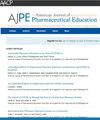Building a Pharmacy Preceptor Development Framework for Nurturing Learner Professional Identity Formation
IF 3.5
4区 教育学
Q1 EDUCATION, SCIENTIFIC DISCIPLINES
引用次数: 0
Abstract
Objective
To explore experiential education (EE) and preceptor development experts’ perceptions for priorities for preceptor development aimed at supporting learner professional identity formation (PIF) and to create a framework for preceptor development to inform future preceptor training programs.
Methods
This multicomponent study involved: 1) conducting virtual focus groups with EE and preceptor development experts to explore perceived preceptor development needs, including content and learning outcomes; 2) utilizing a modified nominal group technique to identify priorities for preceptor development; and 3) creating a preceptor development framework for supporting learner PIF. Transcripts were analyzed to identify specific content areas of focus and practical program insights. Main findings from the focus groups and nominal group technique priorities, informed by PIF and preceptor development literature, were used to create the preceptor development framework.
Results
Twenty preceptor development experts participated in 4 focus groups. Focus group data yielded 5 overarching program insights and several priority content areas to inform the preceptor development framework. The framework created contains content elements for preceptor learning (ie, reflecting on the preceptors’ own PIF journey, using good precepting practices with a PIF lens) and associated preceptor learning outcomes. To support PIF-related learning and preceptor engagement, the framework describes program design elements related to the structure and delivery of programming (ie, reflection, peer discussion, communities of practice, workplace learning).
Conclusion
This study expands on existing frameworks for preceptor development that focus on competency to guide EE and ensure preceptors are equipped to support and nurture learners in their PIF.
构建培养学习者职业认同的药学导师制发展框架。
目的:探讨体验式教育(EE)和导师发展专家对导师发展优先级的看法,旨在支持学习者职业认同形成(PIF),并创建一个导师发展框架,为未来的导师培训计划提供信息。方法:这项多组件研究包括:1)组织情感表达和训导发展专家的虚拟焦点小组,探索感知到的训导发展需求,包括内容和学习成果;2)利用改进的名义群体技术(NGT)确定训导发展的优先事项;3)创建一个支持学习者PIF的训导发展框架。对成绩单进行分析,以确定重点的具体内容领域和实际的程序见解。焦点小组和NGT优先事项的主要发现,以及PIF和训导发展文献的信息,被用于创建训导发展框架。结果:20名教师发展专家参加了4个焦点小组。焦点小组的数据产生了五个总体计划的见解和几个优先内容领域,以告知训导开发框架。创建的框架包含训导学习的内容元素(即,反思训导自己的PIF旅程,使用PIF镜头下的良好训导实践)和相关的训导学习成果。为了支持与pif相关的学习和导师参与,该框架描述了与编程的结构和交付相关的程序设计元素(即,反思、同行讨论、实践社区、工作场所学习)。结论:本研究扩展了现有的指导者发展框架,这些框架侧重于指导情感表达的能力,并确保指导者有能力支持和培养学习者的情感表达。
本文章由计算机程序翻译,如有差异,请以英文原文为准。
求助全文
约1分钟内获得全文
求助全文
来源期刊
CiteScore
4.30
自引率
15.20%
发文量
114
期刊介绍:
The Journal accepts unsolicited manuscripts that have not been published and are not under consideration for publication elsewhere. The Journal only considers material related to pharmaceutical education for publication. Authors must prepare manuscripts to conform to the Journal style (Author Instructions). All manuscripts are subject to peer review and approval by the editor prior to acceptance for publication. Reviewers are assigned by the editor with the advice of the editorial board as needed. Manuscripts are submitted and processed online (Submit a Manuscript) using Editorial Manager, an online manuscript tracking system that facilitates communication between the editorial office, editor, associate editors, reviewers, and authors.
After a manuscript is accepted, it is scheduled for publication in an upcoming issue of the Journal. All manuscripts are formatted and copyedited, and returned to the author for review and approval of the changes. Approximately 2 weeks prior to publication, the author receives an electronic proof of the article for final review and approval. Authors are not assessed page charges for publication.

 求助内容:
求助内容: 应助结果提醒方式:
应助结果提醒方式:


